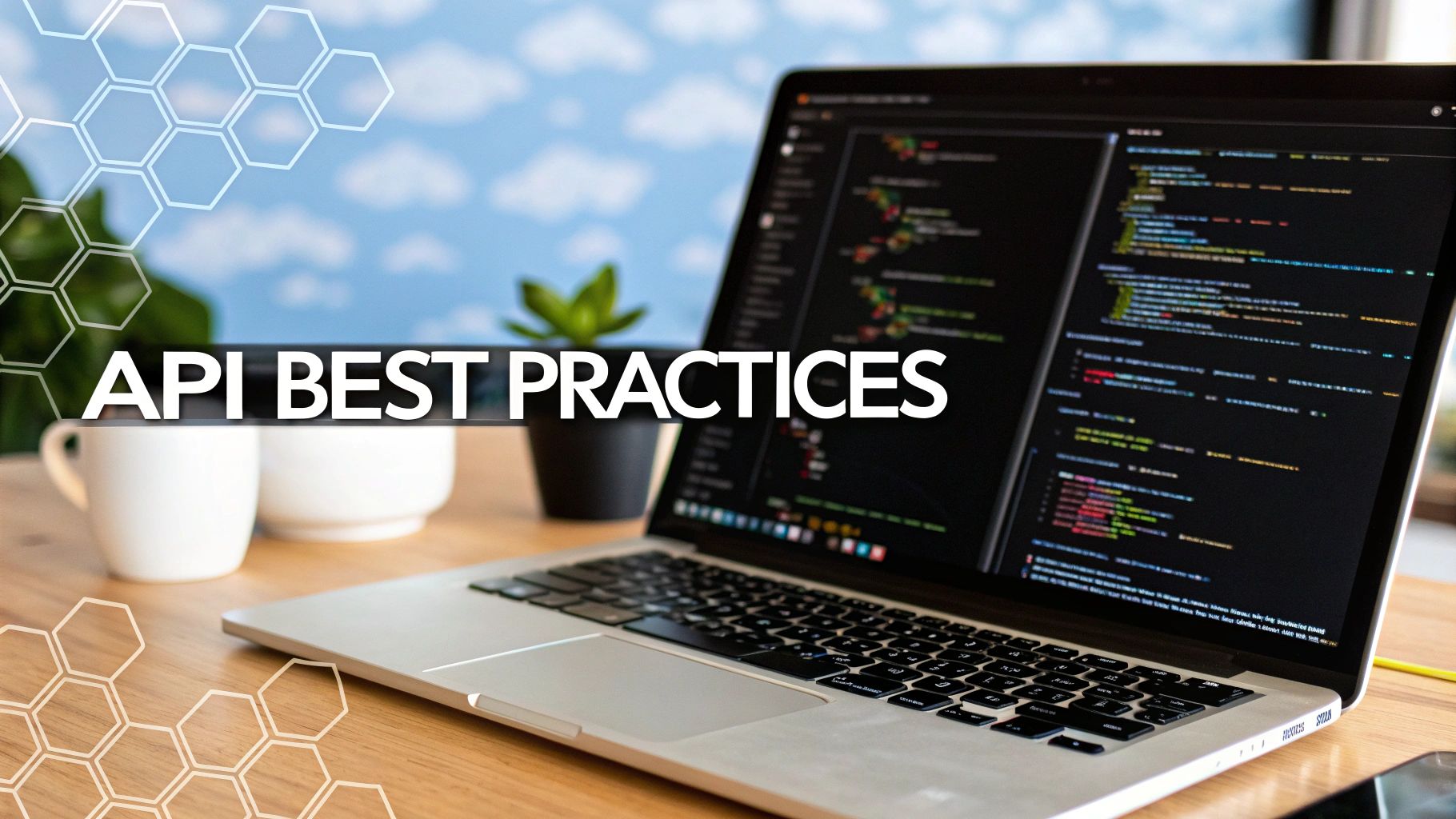Unlocking SaaS Growth: Mastering API Integration Best Practices
For SaaS businesses like Refgrow, robust API integrations are essential for scalability, extensibility, and creating a thriving ecosystem. This listicle unpacks seven crucial API integration best practices, providing actionable insights and real-world examples to empower your SaaS growth in 2025. These practices will not only optimize performance and enhance security but also open doors to new partnerships and revenue streams. When building SaaS products, effective dashboards are key, providing clear visibility into key metrics. For insights on creating effective dashboards, check out this helpful resource: Unlocking Marketing Insights with Effective Dashboards. Source: Marketing Dashboard Best Practices: Maximize Data Insights from Metrion.
This guide cuts through the noise, offering clear, concise advice you can implement immediately. We'll explore practical aspects of API integration, including:
Robust Error Handling and Status Codes: Learn how to design resilient integrations that gracefully handle errors, providing informative feedback to both users and developers.
Authentication and Authorization: Secure your API integrations by implementing robust authentication and authorization mechanisms, protecting sensitive data and ensuring only authorized users have access.
Idempotency: Understand the importance of idempotency in API design and learn how to build integrations that can handle repeated requests without unintended side effects.
Rate Limiting and Throttling: Protect your API from abuse and maintain optimal performance by implementing effective rate limiting and throttling strategies.
Versioning: Future-proof your integrations with proper versioning strategies, allowing for seamless updates and backward compatibility.
Logging and Monitoring: Gain insights into your API integrations with comprehensive logging and monitoring, enabling proactive identification and resolution of issues.
RESTful Design Principles: Leverage the power of RESTful design principles to create consistent, predictable, and easy-to-use APIs.
By implementing these API integration best practices, you can transform your SaaS product into a robust, scalable, and secure platform primed for growth. Let's dive in.
1. Use Robust Error Handling and Status Codes
Effective API integration hinges on anticipating and managing potential issues. Robust error handling is not just a best practice; it's a necessity for building reliable and user-friendly integrations. It involves implementing comprehensive mechanisms that provide meaningful feedback through standardized HTTP status codes and detailed error messages. This empowers API consumers to understand and address issues swiftly, contributing to a smoother integration experience and minimizing frustration. Furthermore, robust error handling maintains system stability by preventing cascading failures and allowing for graceful degradation in the face of unexpected errors.

Why Prioritize Robust Error Handling?
For SaaS businesses, particularly those focused on product-led growth like Refgrow, a seamless user experience is paramount. API integrations play a crucial role in this experience. Well-handled errors translate to less friction for developers integrating with your API, fostering adoption and satisfaction. Imagine a scenario where a user encounters a vague error message during integration. This could lead to frustration, support tickets, and ultimately, churn.
Examples of Effective Error Handling
Several leading APIs demonstrate best-in-class error handling. Stripe's API, for instance, provides detailed error responses with specific error codes and helpful suggestions for resolution. Similarly, the GitHub API offers comprehensive error handling, including rate limit information, allowing developers to adjust their integration logic accordingly. Other examples include Twitter API v2's structured error objects and Google Cloud APIs' standardized error model, showcasing the importance of consistency and clarity in error communication.
Actionable Tips for Implementing Robust Error Handling
Here are some practical tips to improve your API's error handling:
- Standardized Error Formatting: Adopt the RFC 7807 Problem Details standard for consistent error formatting. This ensures that error responses follow a predictable structure, making them easier to parse and understand.
- Correlation IDs: Include correlation IDs in error responses to simplify debugging. These unique identifiers allow you to trace a specific request through your system, pinpointing the source of the error more efficiently.
- Field-Level Validation Errors: Provide specific field-level validation errors for form submissions. Instead of a generic "invalid input" message, specify which fields failed validation and why, enabling users to correct their input quickly.
- Circuit Breakers: Implement circuit breakers to prevent cascading failures. If a dependent service experiences issues, a circuit breaker can temporarily halt requests to that service, preventing your API from being overwhelmed.
- Sanitized Error Messages: Log detailed errors internally while returning sanitized messages to clients. This prevents sensitive information from being exposed while still providing helpful feedback to developers. Learn more about effective error handling.
To effectively unlock SaaS growth, it's crucial to focus on API documentation. For further reading, consider these API Documentation Best Practices from DocuWriter.ai to boost developer engagement. Robust error handling, coupled with clear documentation, significantly improves the developer experience and contributes to the success of your API integration strategy. This is particularly crucial for early-stage startups, self-serve SaaS companies, and product-led growth SaaS businesses seeking to attract and retain developers. By adhering to these API integration best practices, you create a more robust and user-friendly integration ecosystem, setting the stage for sustainable growth.
2. Implement Proper Authentication and Authorization
Secure API integration relies heavily on robust authentication and authorization mechanisms. Authentication verifies the identity of users attempting to access the API, while authorization determines what resources they are permitted to access. Implementing these security measures is crucial for protecting sensitive data, maintaining system integrity, and preventing unauthorized access. This is a non-negotiable aspect of API integration best practices, especially for SaaS businesses handling user data.

Why Prioritize Authentication and Authorization?
For SaaS platforms like Refgrow, security is paramount. API integrations, being entry points to your system, demand stringent authentication and authorization protocols. Properly implemented security measures protect your users' data, build trust, and safeguard your business from potential breaches. Failing to secure your API can lead to data leaks, reputational damage, and legal repercussions.
Examples of Effective Authentication and Authorization
Industry-leading APIs exemplify best practices in authentication and authorization. Google APIs leverage OAuth 2.0, allowing secure third-party access to user data while maintaining user control. AWS API Gateway, combined with IAM roles and policies, provides granular control over access to specific AWS resources. Auth0 offers a comprehensive identity platform designed specifically for API security, simplifying authentication and authorization for developers. Other notable examples include Microsoft Graph API's integration with Azure AD and Shopify's OAuth implementation for app developers.
Actionable Tips for Implementing Robust Authentication and Authorization
Strengthen your API's security with these practical tips:
- Always Use HTTPS: Encrypt all API communications with HTTPS to protect data in transit.
- Token Rotation and Expiration: Implement token rotation and short expiration times to minimize the impact of compromised tokens.
- Principle of Least Privilege: Employ scoped permissions, granting users only the necessary access rights to perform their intended actions.
- Secure API Key Storage: Store API keys securely, never exposing them in client-side code.
- Logout and Token Revocation: Implement proper logout and token revocation mechanisms to ensure users can terminate access when needed. Learn more about Implement Proper Authentication and Authorization.
For early-stage startups and self-serve SaaS companies, robust authentication and authorization are essential for building a secure and trustworthy platform. By adhering to API integration best practices, you create a secure environment for your users and safeguard your business from potential threats. This is especially important for product-led growth SaaS businesses, where a secure and reliable API fosters developer confidence and accelerates adoption. Focusing on security through proper authentication and authorization contributes significantly to a positive developer experience and the long-term success of your API integration strategy.
3. Design for Idempotency
Effective API integration relies on predictable and reliable operations. Designing for idempotency is a critical best practice that ensures API calls produce the same result regardless of how many times they are executed. This is particularly important in distributed systems where network failures and retries are common. Idempotency minimizes unintended side effects or duplicate actions, contributing to a more robust and user-friendly integration experience. By implementing idempotent operations, developers can build resilient integrations that gracefully handle unforeseen errors and maintain data consistency.

Why Prioritize Idempotent Design?
For SaaS businesses, especially those embracing product-led growth, ensuring a seamless integration experience is vital. Idempotency directly contributes to this goal by preventing duplicate actions that could lead to data inconsistencies or unexpected charges. Imagine a scenario where a user accidentally clicks the "submit payment" button twice due to a network hiccup. With an idempotent API, this would result in a single payment, preventing frustration and potential support tickets. When implementing authentication and authorization, consider following established patterns like those outlined in these API key best practices.
Examples of Effective Idempotency
Several leading APIs effectively utilize idempotency. Stripe's API, for example, uses idempotency keys to prevent duplicate payments, ensuring users aren't charged multiple times for the same transaction. AWS API operations are also designed for safe retries, enabling developers to reliably manage their cloud infrastructure. Other examples include PayPal's payment processing with duplicate prevention, Shopify's idempotency protection for order creation, and Square's Point of Sale API which safeguards against duplicate transactions.
Actionable Tips for Implementing Idempotency
Here are some practical tips to incorporate idempotency into your API design:
- Client-Generated UUIDs: Use client-generated UUIDs as idempotency keys. This allows clients to uniquely identify each request and ensures that repeated requests with the same key produce the same outcome.
- Target State-Changing Operations: Implement idempotency for all state-changing operations. This includes actions like creating, updating, or deleting resources, ensuring data consistency even with retries.
- Expiration Times: Set appropriate expiration times for idempotency key storage. This prevents stale keys from causing unintended behavior and manages storage requirements effectively.
- Consistent Responses: Return the same response for duplicate requests using the same idempotency key. This provides predictable behavior and simplifies client-side logic.
- Clear Documentation: Document idempotency behavior clearly in your API documentation. This empowers developers to understand how idempotency works and utilize it effectively in their integrations.
By incorporating idempotency into your API design, you enhance its reliability and robustness, contributing significantly to a positive developer experience. This is especially crucial for early-stage startups, self-serve SaaS companies, and product-led growth businesses aiming to attract and retain developers. Prioritizing idempotency alongside other API integration best practices creates a more stable and user-friendly integration ecosystem, fostering growth and user satisfaction.
4. Implement Rate Limiting and Throttling
Controlling the flow of incoming requests to your API is crucial for maintaining stability and preventing abuse. Implement rate limiting and throttling mechanisms to manage the number of API calls clients can make within a specific time window. This protects your backend resources from being overwhelmed by excessive traffic, ensuring fair usage and consistent service availability for all users. Rate limiting acts as a safeguard against malicious attacks, unintentional overuse, and unexpected traffic spikes, contributing to a more robust and reliable API integration experience.

Why Prioritize Rate Limiting and Throttling?
For SaaS businesses, especially those operating on a product-led growth model, maintaining API performance and availability is paramount. Rate limiting and throttling directly impact the user experience by preventing service disruptions. Imagine a scenario where a single user's script inadvertently floods your API with requests, impacting other users' ability to access your service. This can lead to frustration, lost productivity, and ultimately, churn. By implementing these controls, you ensure a consistent and reliable experience for all users.
Examples of Effective Rate Limiting
Several popular APIs showcase effective rate limiting strategies. Twitter's API, for instance, employs comprehensive rate limiting with different tiers based on user authentication and access levels. GitHub's API also implements rate limiting, offering benefits to authenticated users. Google Maps API utilizes a quota system and a pay-per-use model for managing API usage. Reddit's API incorporates rate limiting to prevent spam and maintain community integrity. Discord's API features a sophisticated rate limiting system with a bucket system for granular control over request frequency.
Actionable Tips for Implementing Rate Limiting and Throttling
Here are some practical tips for effectively implementing rate limiting and throttling in your API:
- Informative Headers: Include rate limit information in response headers using standard fields like
X-RateLimit-Limit,X-RateLimit-Remaining, andX-RateLimit-Reset. This provides transparency to API consumers, allowing them to adjust their integration logic accordingly. - Granular Control: Implement different rate limits for different API operations based on their resource cost. This allows you to fine-tune your rate limiting strategy and optimize resource allocation.
- Clear Documentation: Provide clear and comprehensive documentation about your rate limits, explaining how they work and how developers can handle them. This empowers developers to integrate with your API efficiently.
- Exponential Backoff: Implement exponential backoff strategies for retry logic. This prevents clients from repeatedly hitting your API when rate limits are exceeded, allowing your system to recover.
- Multi-Level Limiting: Consider implementing rate limiting at multiple levels, such as IP address, user account, and API key. This adds another layer of protection against abuse and ensures fair usage.
Implementing robust rate limiting and throttling is a critical best practice for any SaaS business offering API integrations. This contributes to a more stable, reliable, and scalable API infrastructure. By adhering to these best practices, you enhance the developer experience and foster a thriving integration ecosystem, driving growth and success for your SaaS product, particularly for early-stage startups, self-serve companies, and those focused on product-led growth.
5. Use Proper Versioning Strategies
Effective API integration relies on stable and predictable interfaces. However, APIs inevitably evolve as features are added, bugs are fixed, and functionalities are improved. This is where versioning comes into play. A well-defined versioning strategy enables you to manage API evolution without disrupting existing integrations, fostering trust and encouraging adoption among developers. Proper versioning allows you to introduce changes and improvements while maintaining backward compatibility, ensuring a smooth transition for your API consumers.
Why Prioritize Proper Versioning?
For SaaS businesses, especially those embracing product-led growth, maintaining backward compatibility is crucial for customer retention. Imagine a scenario where an API update breaks existing integrations for numerous clients. This could lead to widespread disruption, support tickets, and ultimately, churn. A robust versioning strategy mitigates this risk by providing a clear path for introducing changes without impacting existing users.
Examples of Effective Versioning
Several leading APIs demonstrate best-in-class versioning strategies. GitHub, for instance, utilizes URL-based versioning (e.g., /api/v3/, /api/v4/), making it easy for developers to specify which API version they wish to use. Stripe employs date-based versioning with backward compatibility, ensuring that existing integrations continue to function seamlessly even as the API evolves. Other prominent examples include Twitter API's major version iterations (v1.1, v2) and Google APIs' semantic versioning coupled with clear deprecation policies.
Actionable Tips for Implementing Proper Versioning
Here are some practical tips to improve your API's versioning strategy:
- Semantic Versioning: Adopt semantic versioning (major.minor.patch) for clear communication about the nature of changes. Major version changes indicate breaking changes, minor versions introduce new features while maintaining backward compatibility, and patch versions represent bug fixes.
- Deprecation Policies: Provide ample notice (at least 12 months) before deprecating API versions. This allows developers sufficient time to migrate their integrations to the latest version without experiencing disruption.
- Migration Guides: Maintain comprehensive migration guides between API versions. These guides should clearly outline the changes between versions, provide examples, and offer assistance to developers during the migration process.
- Header-Based Versioning: Consider using header-based versioning for cleaner URLs. This approach involves specifying the desired API version in the request header, leaving the URL cleaner and more readable.
- Feature Flags: Implement feature flags for gradual rollouts of new functionality. This allows you to test new features with a subset of users before making them generally available, reducing the risk of introducing breaking changes.
Robust versioning, coupled with proactive communication and detailed documentation, builds trust among developers and fosters a thriving integration ecosystem. This is particularly important for early-stage startups, self-serve SaaS companies, and product-led growth SaaS businesses aiming to attract and retain developers. By adhering to these API integration best practices, you create a more stable, predictable, and developer-friendly API, paving the way for sustainable growth and a positive developer experience.
6. Implement Comprehensive Logging and Monitoring
Effective API integration relies heavily on understanding how the API is performing and behaving in real-world scenarios. Implementing comprehensive logging and monitoring provides crucial visibility into API usage, performance bottlenecks, errors, and security events. This proactive approach enables early issue detection, facilitates performance optimization, and strengthens security incident response, ensuring a robust and reliable integration ecosystem. By tracking key metrics and events, you gain valuable insights that empower data-driven decisions to enhance the API integration experience.
Why Prioritize Comprehensive Logging and Monitoring?
For SaaS businesses striving for product-led growth, like Refgrow, understanding user behavior and API performance is essential. Comprehensive logging and monitoring provides the data needed to identify areas for improvement, optimize resource allocation, and proactively address potential issues before they impact users. Imagine a scenario where a critical API endpoint experiences a sudden spike in latency. Without proper monitoring, this issue could go unnoticed, leading to degraded performance and user frustration. With comprehensive logging and monitoring, you can detect such anomalies in real-time and take corrective action swiftly.
Examples of Effective Logging and Monitoring
Leading companies demonstrate the value of robust API logging and monitoring. Netflix, for instance, leverages comprehensive API monitoring with custom dashboards to track performance and availability across its vast infrastructure. Uber utilizes real-time API monitoring for critical operations, ensuring a seamless ride-hailing experience. Airbnb's performance monitoring and alerting systems enable proactive identification and resolution of performance bottlenecks. Spotify employs API analytics to gather insights into music consumption patterns, driving improvements in their recommendation engine. Amazon's CloudWatch integration provides seamless monitoring for AWS API interactions, demonstrating the importance of integrating logging and monitoring within cloud environments.
Actionable Tips for Implementing Comprehensive Logging and Monitoring
Here are some practical tips to enhance your API's logging and monitoring capabilities:
- Structured Logging Formats: Use structured logging formats like JSON for easier parsing and analysis. This allows you to extract specific data points from logs efficiently and integrate them with monitoring tools.
- Correlation IDs: Implement correlation IDs to trace requests across multiple services. This simplifies debugging by providing a unique identifier for each request, allowing you to follow its path through the system.
- Automated Alerts: Set up automated alerts for critical error rates and performance degradation. This enables proactive intervention and prevents minor issues from escalating into major outages.
- Holistic Monitoring: Monitor both technical metrics (e.g., latency, error rates) and business KPIs (e.g., conversion rates, user engagement). This provides a comprehensive view of API performance and its impact on business objectives.
- Log Retention Policies: Implement log retention policies to manage storage costs and comply with data retention regulations. This ensures that you retain necessary log data while minimizing storage overhead.
Implementing comprehensive logging and monitoring is fundamental to successful API integration. By adopting these best practices, SaaS businesses can gain valuable insights into API performance, proactively address potential issues, and optimize the integration experience for their users. This data-driven approach is crucial for early-stage startups, self-serve SaaS companies, and product-led growth SaaS businesses aiming to achieve sustainable growth through seamless API integrations. By prioritizing logging and monitoring, you build a more robust and reliable API ecosystem, fostering developer confidence and driving user satisfaction.
7. Follow RESTful Design Principles
REST (Representational State Transfer) isn't just a buzzword; it's a powerful architectural style for creating APIs that are intuitive, scalable, and maintainable. By adhering to RESTful principles, you create a consistent and predictable experience for developers integrating with your API. This involves using standard HTTP methods (GET, POST, PUT, DELETE) to interact with resources, leveraging clear URL structures, and ensuring stateless communication. Embracing REST simplifies integration, reduces development time, and promotes interoperability.
Why Prioritize RESTful Design?
For SaaS businesses, especially those operating in a product-led growth model like Refgrow, developer experience is paramount. RESTful APIs are easier to understand and use, reducing the learning curve for developers and encouraging adoption. This translates to faster integrations, quicker time-to-value, and increased customer satisfaction. Imagine a complex API with inconsistent URL structures and custom methods. This would likely deter developers and hinder integration efforts.
Examples of Effective RESTful Design
Several popular APIs exemplify RESTful principles. GitHub's API provides a clear resource-based structure for accessing repositories, users, and other entities. Spotify's Web API allows developers to interact with music catalogs and user data through well-defined RESTful endpoints. Similarly, Shopify's Admin API leverages RESTful design for managing e-commerce resources, demonstrating the practicality and scalability of this approach. Other noteworthy examples include Slack's API for workspace and messaging resources and Twilio's API for communication services, all demonstrating RESTful design in action.
Actionable Tips for Implementing RESTful Design
Here are practical tips to make your API more RESTful:
- Resource-Based URLs: Use nouns to represent resources (e.g.,
/users,/products) in your URL structure, avoiding verbs (e.g.,/createUser,/getProduct). - Consistent URL Patterns: Maintain consistency in your URL patterns across all endpoints. This predictability simplifies navigation and integration.
- Proper HTTP Method Usage: Utilize HTTP methods correctly: GET for retrieving data, POST for creating resources, PUT for updating resources, and DELETE for deleting resources.
- Hypermedia Links: Provide relationships between resources through hypermedia links. This allows developers to discover related resources easily, enhancing API navigation.
- Query Parameters: Leverage query parameters for filtering, sorting, and pagination, enabling developers to refine their data retrieval. Learn more about SaaS integration platforms and how RESTful APIs contribute to seamless integration experiences.
By following these RESTful design principles, you can create a robust, scalable, and developer-friendly API. This contributes significantly to a positive developer experience, fostering wider adoption and ultimately driving growth for your SaaS business. This is especially relevant for early-stage startups and self-serve companies relying on seamless integrations to expand their user base. Applying these API integration best practices establishes a user-friendly integration environment, creating a foundation for sustainable growth.
API Integration Best Practices Comparison
| Practice | Implementation Complexity 🔄 | Resource Requirements ⚡ | Expected Outcomes 📊 | Ideal Use Cases 💡 | Key Advantages ⭐ |
|---|---|---|---|---|---|
| Use Robust Error Handling and Status Codes | Medium - requires consistent formats and handling across endpoints | Moderate - additional payload and logging | Clear error feedback, improved debugging, system stability | APIs needing reliable client feedback and fault tolerance | Enhanced debugging, better developer experience, fault tolerance |
| Implement Proper Authentication and Authorization | High - multiple auth methods and token management | High - infrastructure for tokens and secure storage | Strong security posture, controlled access, compliance | APIs handling sensitive data or requiring secure user access | Strong security, granular access control, audit trails |
| Design for Idempotency | Medium to high - tracking uniqueness and retries | Moderate - storage for idempotency keys | Safe retries, duplicate prevention, improved reliability | Payment systems, transaction APIs, retry-prone operations | Prevents duplicates, safer retries, improved reliability |
| Implement Rate Limiting and Throttling | Medium - requires tracking and enforcement logic | Moderate to high - infrastructure for counters and limits | Fair usage enforcement, abuse prevention, predictable performance | Public APIs exposed to many users, protecting backend stability | Protects resources, fair access, predictable performance |
| Use Proper Versioning Strategies | Medium - managing multiple versions and backward compatibility | Moderate - testing and deploying multiple versions | Smooth API evolution, backward compatibility | APIs with frequent updates and evolving features | Smooth transitions, clear communication, flexible evolution |
| Implement Comprehensive Logging and Monitoring | Medium - setup extensive logs and monitoring dashboards | High - storage and processing of logs | Proactive issue detection, performance insights, security monitoring | Large-scale APIs needing reliability and security oversight | Faster issue resolution, security alerts, data-driven optimization |
| Follow RESTful Design Principles | Low to medium - requires consistent design and conventions | Low - standard HTTP features and statelessness | Intuitive, scalable, maintainable APIs | General-purpose APIs needing standardized, scalable design | Predictable API design, scalability, wide ecosystem support |
Building a Future-Proof Integration Strategy
This article has explored several key API integration best practices, providing actionable insights for SaaS businesses like Refgrow. From robust error handling and authentication to rate limiting and versioning, each element plays a crucial role in building reliable and scalable integrations. Mastering these concepts is not just a technical necessity; it's a strategic advantage that can significantly impact your business's growth and sustainability.
Key Takeaways for Seamless Integrations
Let's recap the most important takeaways:
- Prioritize security: Implementing proper authentication and authorization safeguards your data and protects against unauthorized access.
- Enhance reliability: Robust error handling, idempotency, and rate limiting ensure consistent performance and prevent disruptions.
- Embrace scalability: Proper versioning strategies and RESTful design principles enable your API to evolve and adapt to future needs.
- Gain valuable insights: Comprehensive logging and monitoring empower you to identify and address issues proactively.
By consistently applying these principles, you can build integrations that are not only functional but also resilient, adaptable, and secure.
Actionable Next Steps for API Excellence
Implementing these best practices isn't a one-time task; it's an ongoing process of refinement and improvement. Start by auditing your existing integrations. Identify areas where you can strengthen security, improve reliability, and enhance scalability. Prioritize the practices that align with your business goals and gradually implement them across your API ecosystem.
The Long-Term Benefits of Robust API Integrations
Investing in robust API integrations pays dividends in the long run. It streamlines your workflows, enhances user experience, and unlocks new opportunities for growth and innovation. In today's interconnected world, seamless API integrations are essential for building a competitive and future-proof SaaS business. They are the foundation upon which successful partnerships are built, enabling data sharing, automation, and expanded functionality. Furthermore, a well-designed API can become a valuable product in itself, opening up new revenue streams and attracting a broader customer base.
By adhering to these API integration best practices, you position your business for long-term success in the rapidly evolving SaaS landscape. You empower your team to build integrations that are not only technically sound but also strategically advantageous. This proactive approach ensures your platform remains adaptable, scalable, and ready to capitalize on emerging opportunities.
Ready to streamline your affiliate program integration and leverage the power of a robust API? Explore how Refgrow simplifies the process with its REST API designed for seamless embeddability, embodying the API integration best practices discussed in this article. Visit Refgrow today to learn more.

